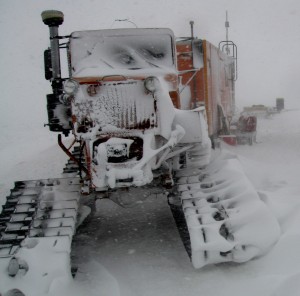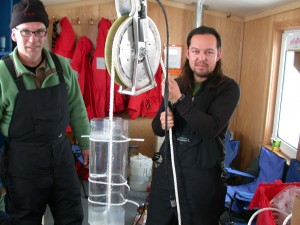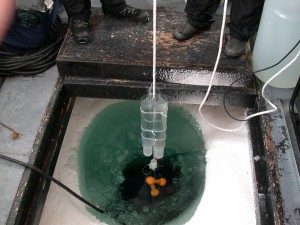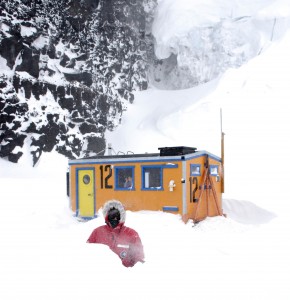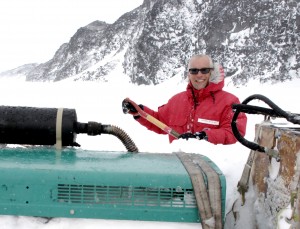The next day offered more snow and wind: we still needed handheld radios anytime we ventured between the warming hut and any of the vehicles. The wind was so strong that snow began drifting up through the dive hole in the warming hut, and the windows completely glazed over with snow. At one point Abigail ventured out with her camera, so follow this link if you want to experience a condition 1 Antarctic storm from the safety and comfort of your chair. Needless to say trips outside were kept to a minimum, and we were sure to keep hot chocolate and coffee at hand.
So even though it was a day stuck indoors, there was plenty of science to do, and we considered it an incredible stroke of good luck to be stuck in a hut with a convenient access hole to the Ross Sea! Dawn was able to pull some plankton from the sea ice and view them in the ambient light of one of the windows. Abigail’s focus of research is metal chemistry in the marine environment, and she was able to do some prep work, soaking and treating all of her Nansen Bottles to remove any traces of contaminating metals. Metal concentrations in seawater are notoriously difficult to quantify as all of the tools we use are contaminated with metals, including the plastic bottles and lines used to deploy them. Soaking them in seawater for 24 hours will mitigate the problem, so we lowered them below the sea ice.
Mak Saito also brought his custom-made sediment trap, and this too was deployed for a 48 hour incubation below the ice. Sediment traps are particularly important tools in oceanography, as they help scientists quantify the flow, or flux, of dead and dying plankton from the sruface to the ocean depths. As plankton sink, they are effectively removing organic carbon and nutrients from the ocean surface, so understanding this rate has important implications for the speed at which carbon is removed from the atmosphere and sequestered in the ocean depths.
It also turned out that the dive hole was not a one way street: throughout the day Weddell seals would use the hole in the ice as an access point for air. Weddell seals are master divers, and they can dive up to 700 m (2100 ft) deep, and they can stay underwater for over an hour as they search for fish, squid and krill. When they would pop up in our dive hut, they seemed very keen for air, and they would spend a full minute hyperventilating to clear the carbon dioxide out of their lungs before disappearing back below the ice.
Eventually the storm slowed down enough that we could start to dig ourselves out. There was still snow blowing down off of the Erebus glaciers, but by our third day in the hut, visibility started to improve enough that we could shovel path and clear vehicles. Dawn and Abigail cleared a path to our lab sled while Mak, Jeff and I cleared away the generator and transferred fuel to the Pisten Bully. I was also able to use the Iridium satellite phone to get a call out to my wife, who is currently in Bukhara, Uzbekistan: making a call from a fish hut in Anarctica to a 14th century silk road city is a really mind-bending use of technology!
The Pisten Bully needed to be warmed for two hours before we could start it up, but once it was running we decided to head back to McMurdo while the weather was good. We has GPS coordinates to get us back to the Cape Evans sea ice road, and from there it was relatively easy to follow the flags back to McMurdo Station. On Monday we will head back out, and so hopefully our next post will be from station one. Until then — keep warm!

